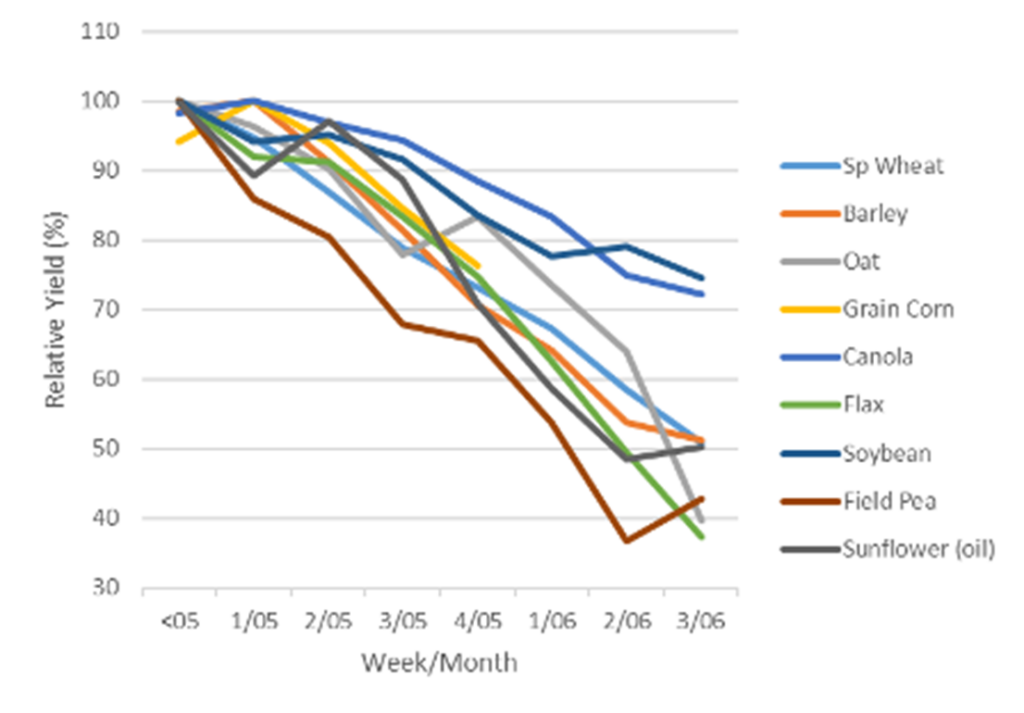Early seeding – benefits and risks
Go to the field earlier and get seeding done.
Benefits
- Yield response by some crops;
- Free up time to work on other crops;
- Reduce a weed spreading on the fields;
- Leverage moisture in the soil.
Risks
- Low germination, reduced plants population.
- Fungal infections and pests.
- Keeling frost risk. Reseeding risk
- Other related risks
Risks and Rewards of Early Seeding
Manitoba Agriculture and Resource Development
Risks and Rewards of Early Seeding
In an early and dry spring, early seeding will inevitably happen. While seeding in mid-April is not uncommon in some parts of Manitoba, in recent years, dry soil conditions have made it possible for seeding to start even earlier. Before putting seed in the ground, it is important to think about the benefits and risks of early seeding.
Benefits of Early Seeding
The biggest driver for early seeding is the potential for higher yields. Farmer-reported data from Manitoba Agricultural Services Corporation (MASC) shows that earlier seeding dates generally result in higher yields.
The figure below shows average relative yield of various crops as seeding date moves from late April to mid June. Average relative yields were highest for spring wheat, oat, flax, soybean, field pea, and sunflower for the late April seeding date. Barley, grain corn, and canola yields were highest on average when seeded the first week of May. It is important to keep in mind that the data presented is for final crop in the ground.

Figure 1: Average relative yields reported to MASC during each sowing week for selected crops grown in Manitoba for the period of 2010-2019. The vertical axis represents the percentage of average yield, and the horizontal axis represents the week each crop is sown. Source: Manitoba Agricultural Services Corporation Seeded Acreage Report.
Table 1: Minimum average soil temperature for germination for various crops
| Crop | Temperature (°C) |
| Wheat | 4 |
| Barley | 4 |
| Oats | 4 |
| Corn | 10 |
| Canola | 5 |
| Flax | 9 |
| Sunflower | 6 |
| Edible Beans | 10 |
| Peas | 5 |
| Soybeans | 10 |
Earlier planted crops may be better able to use available soil moisture through the growing season, and may increase the likelihood of avoiding of high temperatures and dry conditions during flowering and grain fill.
Research conducted in Alberta and Saskatchewan on ultra-early seeding dates for spring wheat has found that optimal seeding time for spring wheat is when the soil temperature is between 2°C and 6°C (Colliers et al. 2020).
Risks of Early Seeding
Cold soil temperatures and frost damage are the main risks of early seeding. If the soil is too cold for germination, emergence may be uneven or inadequate.
Table 1 shows the minimum germination temperatures for several crops. As soil temperatures increase, germination and emergence are faster and more uniform. If seeding into cold soils, it may be beneficial to account for greater seedling mortality as percent emergence is usually higher on warm soils.
If conditions are cool and wet after seeding, emergence will be slow, making the seedlings more susceptible to diseases and root rots. Seed treatments are recommended when seeding early, but check to see how long seed treatments are effective. Once the crop emerges, frost is the main risk. Tolerance to freezing temperatures varies, depending on the crop type and the plants growth stage.
Frost injury depends on air temperature, length of time the temperature is below freezing, soil moisture, residue levels, temperatures following the sub-zero temperatures, and the plants’ growth stage.
Early Seeding Wheat
There are a few benefits of seeding wheat earlier, the first one is yield response. It is proven that the earliest seeding dates produce the highest yields and the highest return In Western Canada. According to trials and researches organized by Collier, a PhD candidate in agronomy at the University of Alberta, seeding “From 2 C to 6 C soil temperature, that’s when the peak yield opportunity occurred, which is quite a bit earlier than most growers are seeding,”. Collier stated that he “was pleasantly surprised to find out that there wasn’t really a penalty for going too early. “
Second, by seeding wheat earlier in the spring, you free up time to work on other crops in the fields. You significantly reduce the pressure on the equipment and labor forces.
The third reason to seed wheat earlier is that you reduce a weed spreading on the fields. Earlier seeded wheat successfully competes with many weeds and suppress some weed spaces.
And last but not list, this approach can reduce N lost in the earlier spring. Seeded wheats actively consume released N that may be lost by denitrification when soils are temporarily wet in early spring.
To sum up, there are a few reasons to consider earlier seeding of wheat. No doubt that, farmers will have many benefits going to the fields earlier. Sure, farmers should consider good seed treatment products and practices to save seeds and seedlings in the vet spring conditions, chose the right variety of wheat and consult with the local agronomist to find the best approach and minimize possible risks. However, the result will pay off.
Please contact your agronomist for more information about seeding time and rates.
You also might like
Crop rotation – effective tool to control pests, weeds and reduce expenses in crop production
Soil test – how to read soil analysis.
Low Maintenance Pets For Kids That Are Easy to Take Care Of


